Family : Lutjanidae

Text © Giuseppe Mazza

English translation by Mario Beltramini
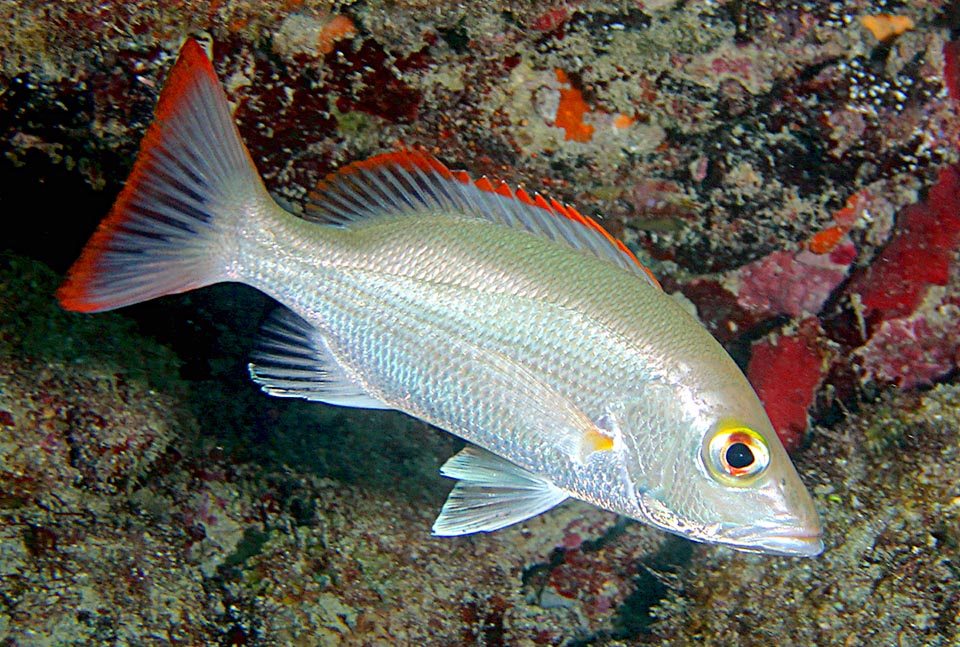
Averagely 38 cm long, Lutjanus mahogoni is a fish present in the western Atlantic tropical and subtropical waters, very common in the Caribbean © Kevin Bryant
Inserted in the class of the Actinopterygii, the ray-finned fishes, and in the great order of the Perciformes, Lutjanus mahogoni (Cuvier, 1828) is known as Mahogany Snapper, even if taxonomically it does not belong like these last to the family of the Sparidae but of the Lutjanidae, group counting 17 genera and 113 species, present in the tropical and subtropical seas of the whole planet.
The genus Lutjanus, created for Lutjanus lutjanus by Bloch in 1790 and assigned presently to about 70 species, originates from the local Indonesian name, whilst the specific mahogoni evokes the colour of the mahogany wood due to the reddish shades of this fish.
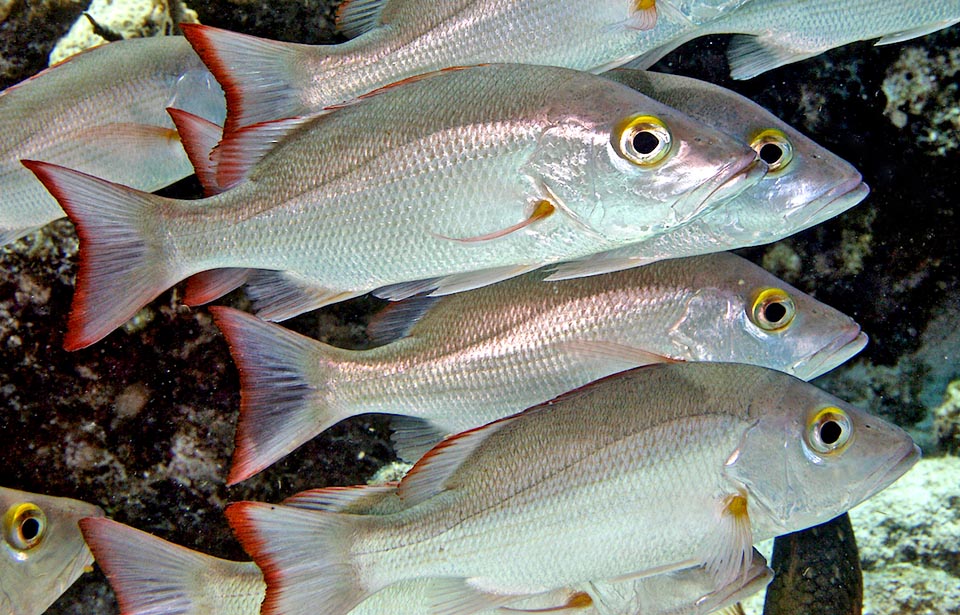
During the day often forms small aggregations and hunts by night small fishes, shrimps, crabs and cephalopods © Allison & Carlos Estape
Zoogeography
Present in western Atlantic from North Carolina and the Gulf of Mexico up to the coasts of Brazil, Lutjanus mahogoni is a very common fish in the Caribbean.
Ecology-Habitat
Even if it may go down up to about 100 m of depth, and some say 200, it mainly goes swimming in shallow waters, between 5 and 20 m.
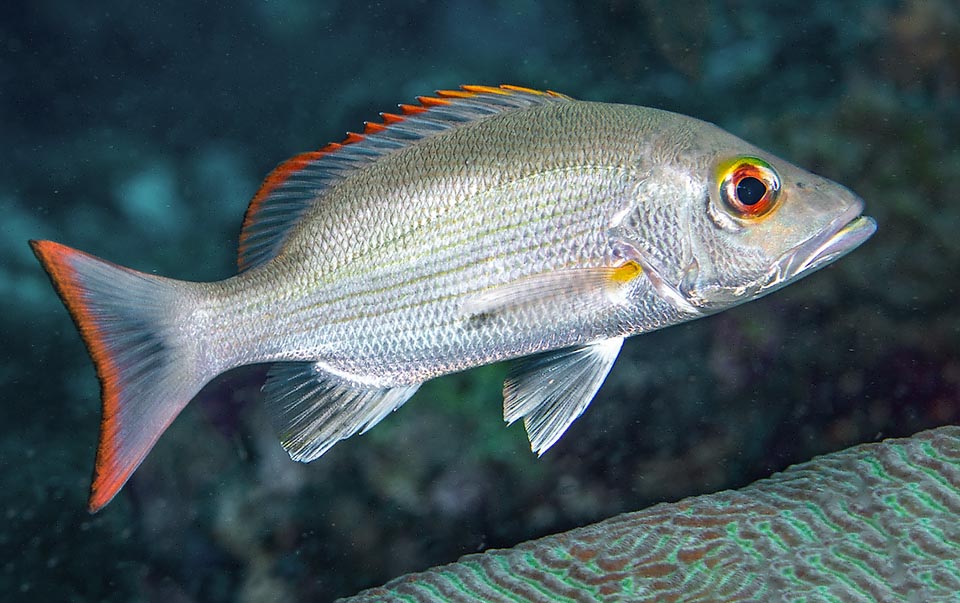
The body, silvery with reddish hues, has the back darker, olive grey. The edge of the caudal and of the dorsal fins is always red © Allison & Carlos Estape
It moves in rocky and madreporic environments, where it can form during the day even big aggregations, whilst it is more rare to find it on the sandy bottoms and in the submerged prairies of phanerogams.
Morphophysiology
Even if its current size is about 38 cm, Lutjanus mahogoni can reach the length of 45 cm with a maximum weight of 1,3 kg. The relatively tall body, olive grey on the back, is, in its whole, of silvery colour with reddish reflections. The edge of the dorsal fin and the outline of the caudal one are red.
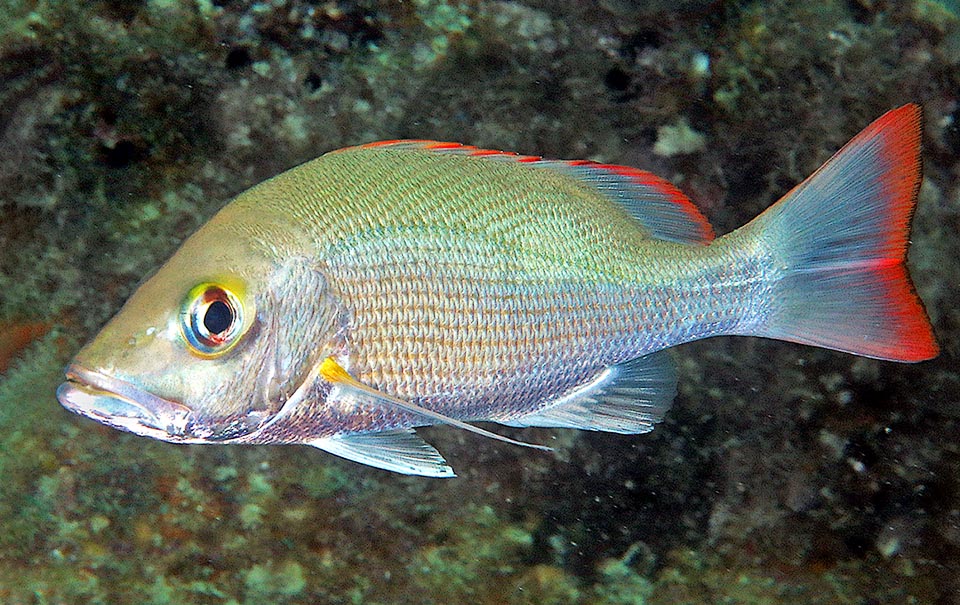
The snout appears naked, scaleless. These, big, go up obliquely over the lateral line, whilst below they form horizontal lines © Kevin Bryant
At times it has been noted, as in the juvenile livery, a showy dark spot on the lateral line under the lst dorsal spines. The eye is big, yellowish like the base of the long pectoral fins.
The snout presents flat with protruding lower jaw. Both have sharp canines, longer at the top, to which add some small teeth arranged anchor-like on the palate.
The mouth, relatively big with the upper jaw slightly protruding, is placed below, almost on the extension of the belly, with the articulation aligned on the middle of the eye.
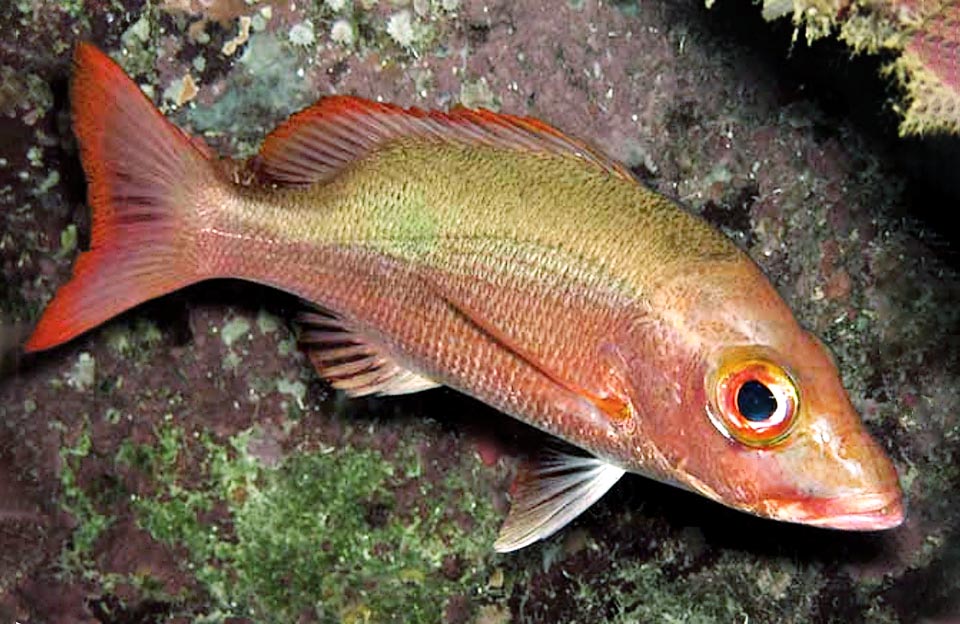
At times the fish is almost all red. The lower jaw is slightly longer than the other and both have sharp canines © Mickey Charteris
The lateral line is arcuate and well visible.
Over it, big scales rise obliquely towards the back, whilst below they form horizontal lines. They are present also on the cheeks and the operculum whilst the snout is naked.
The preoperculum is serrated, especially on the showy lower protrusion.
There is only one dorsal fin with a slight notch after the 10 spiny rays followed by 11-12 soft rays.
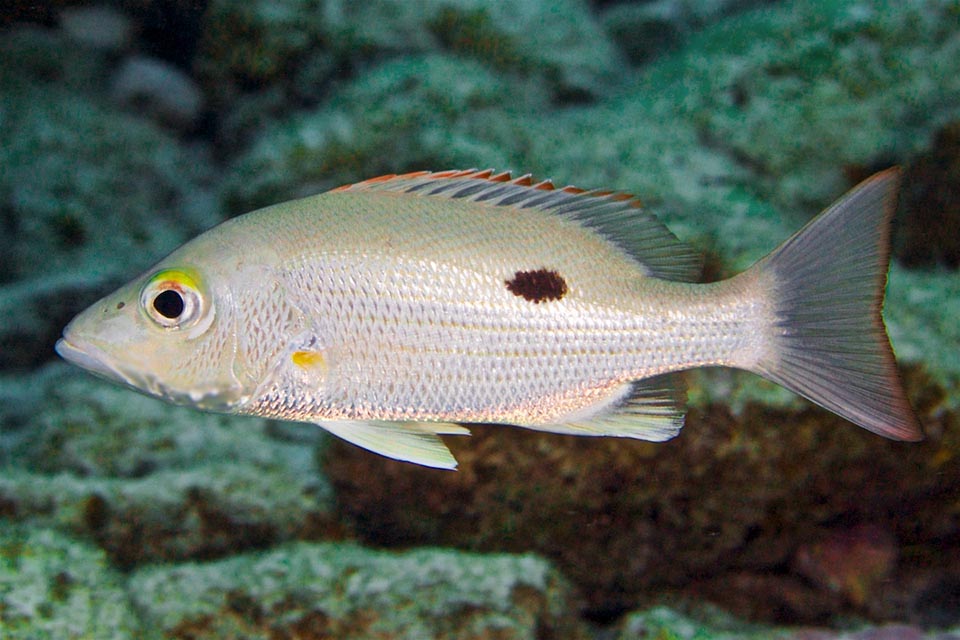
Some specimens have a showy dark spot, always present in juveniles, on the lateral line under the last spines of the dorsal fin © Allison & Carlos Estape
The anal has 3 spiny and 8 unarmed rays; the sharp pectoral fins 14-15 rays and the caudal is slightly biforked.
Ethology-Reproductive Biology
Lutjanus mahogoni goes hunting during the night small bottom fishes, very often Haemulidae like Haemulon flavolineatum and Brachygenys chrysargyreum, but also shrimps, crabs and cephalopods.
It respects, however, as per normal practice in the cleaning stations, the Cleaner shrimp of Grabham (Lysmata grabhami) and the Sharknose goby (Elacatinus evelynae) who free it from the skin parasites.
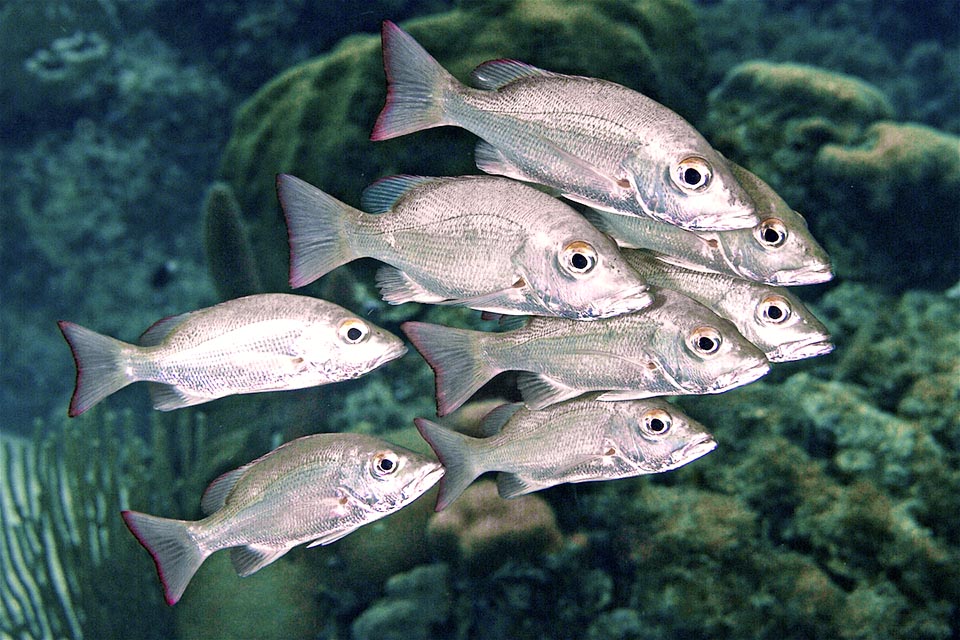
There are no reproduction aggregations and the couples entrust the fecundated eggs to the currents. They hatch after one day and then reach the bottoms rich in hideouts © Allison & Carlos Estape
It is a species that loves the heat and reproduces, depending on the locations, from May to July. There are no aggregations and the couples entrust the fecundated eggs to the currents.
They hatch in one day with less than 1 cm long larvae that then reach the seabeds rich in hideouts, where they grow with a lifespan of 18 years.
The resilience of the species is low as at least 4,5-14 years are needed for doubling the populations, and the fishing vulnerability, moderately high, marks 53 on a scale of 100.
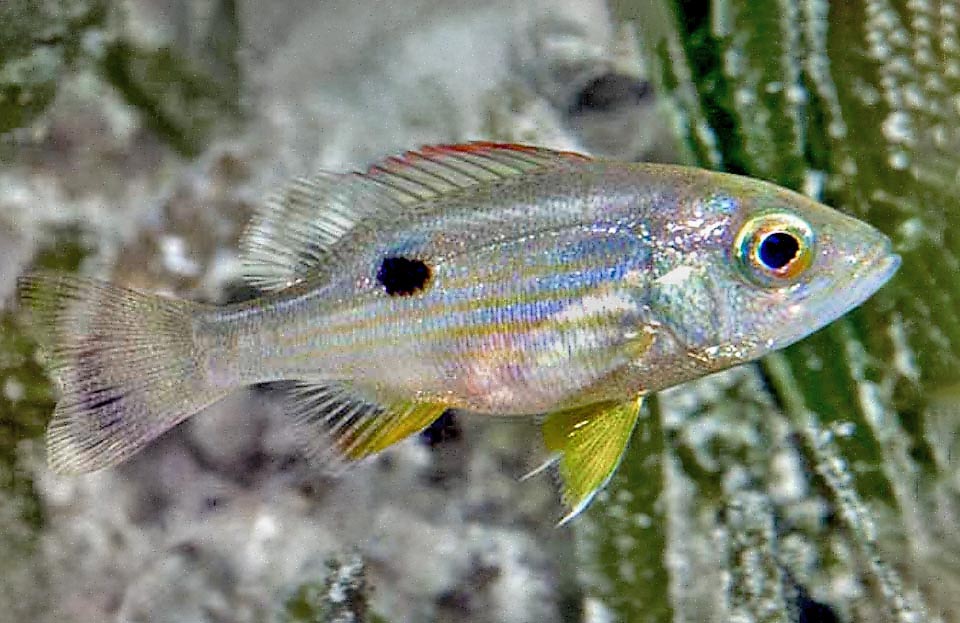
Juvenile. Lifespan for Lutjanus mahogoni is about 18 years. Flesh is good, but particularly in the bigger specimens, is sometimes at ciguatera risk © Allison & Carlos Estape
Lutjanus mahogoni is in fact present in the local markets when gets caught in the nets, even if the flesh, considered good, is at times toxic, at risk of ciguatera, a serious food poisoning, that occurs when these fishes have been predating for years organisms that accumulate in their tissues the toxin produced by the dinoflagellate Gambierdiscus toxicus.
However, considering its vast diffusion, Lutjanus mahogoni from 2015 appears as “LC, Least Concern”, in the IUCN Red List of the endangered species.
Synonyms
Mesoprion mahogoni Cuvier, 1828;Mesoprion ricardi Cuvier, 1828; Mesoprion ojanco Poey, 1860.
→ For general information about FISH please click here.
→ For general information about BONY FISH please click here
→ For general information about CARTILAGINOUS FISH please click here.
→ To appreciate the BIODIVERSITY of BONY FISH please click here.
→ To appreciate the BIODIVERSITY of CARTILAGINOUS FISH please click here.
